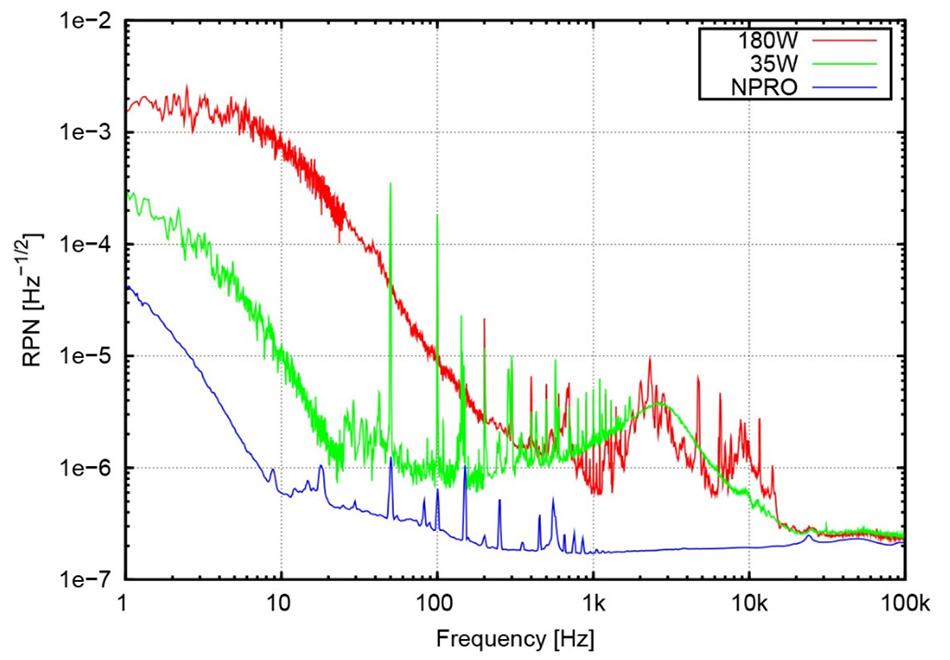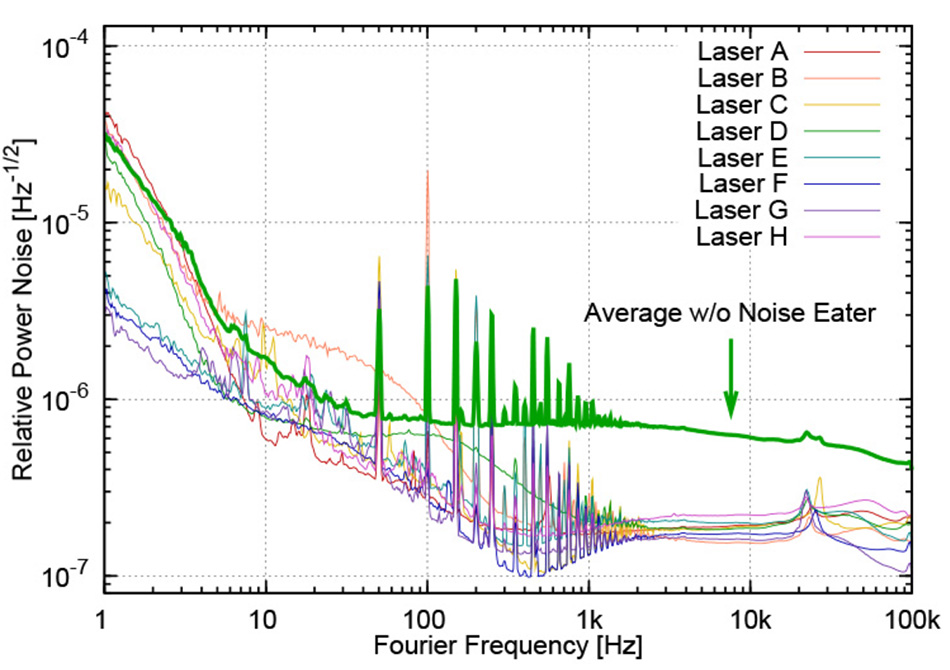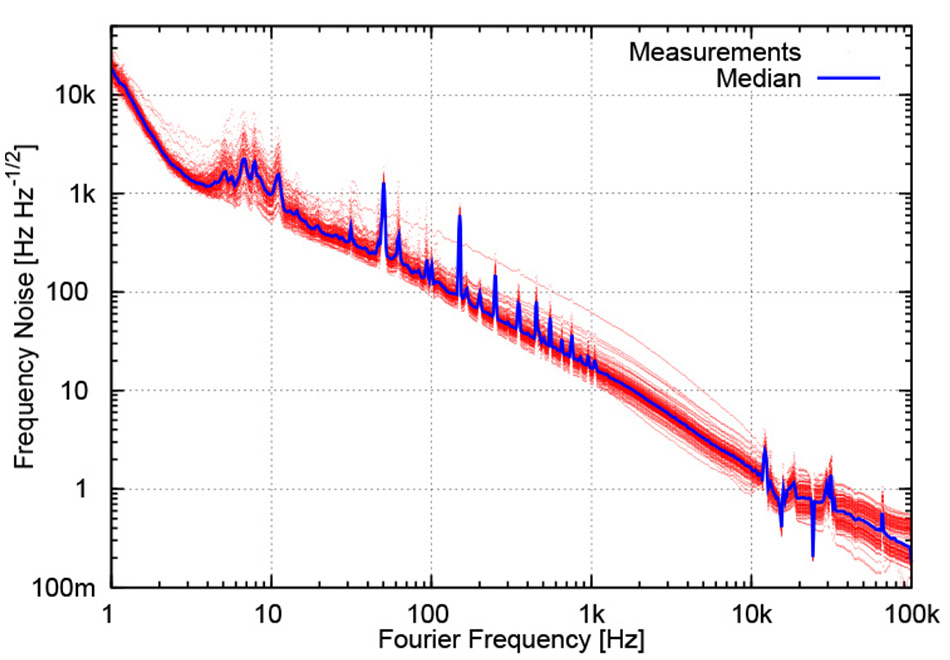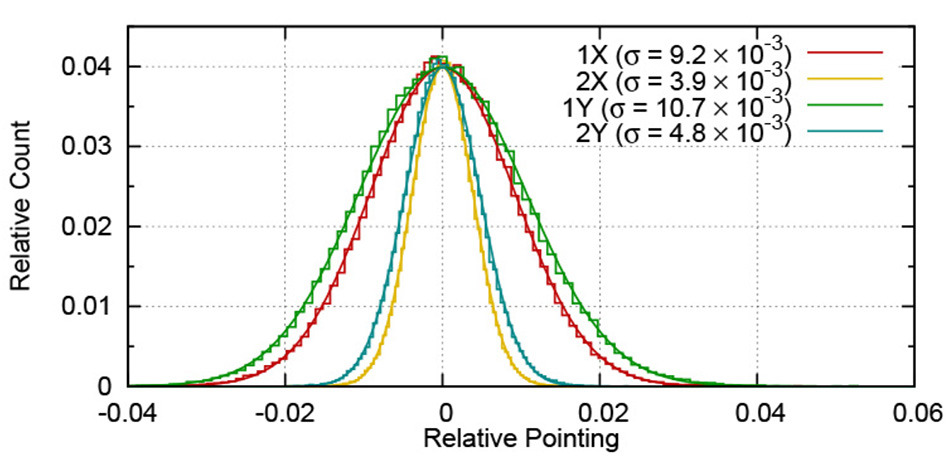WHITE PAPER
Mephisto Applications in Gravitational Waves Detection
Low Noise and High Unit-to-Unit Consistency
Peer-reviewed and other independent third-party assessments of the performance of Mephisto for cutting edge gravitational wave applications, as well as relevant life tests, all confirm the superior performance, reliability and high unit-to-unit consistency of these lasers.
Introduction
In terms of low output noise and ultra-narrow linewidth requirements, few would argue that gravitational wave detection (GWD) based on long path interferometry currently represents the most demanding application for narrow linewidth CW lasers – even more than atom cooling. A number of successful detections of gravitational waves were performed at the Laser Interferometer Gravitational-Wave Observatory (LIGO) that operates at two sites in the US, one in Livingston, Louisiana, and another in Hanford, Washington and also at VIRGO gravitational wave detector in Italy. To differentiate LIGO from earlier setups, this is often referred to as Advanced LIGO. In this white paper, we look at the noise requirements for this application and discuss how and why Coherent Mephisto lasers are used in LIGO and other detectors. We also explore some of the results and conclusions from a third-party study that preceded Mephisto’s selection for use in gravitational wave detectors. This work specifically evaluated the uniformity of Mephisto lasers to assess their suitability for this type of cutting-edge project.
Gravitational Wave Detection – the Lowest Noise Application
Gravitational wave detection projects are targeted at direct observations of gravitational waves – minute ripples in space time, predicted by Einstein as far back as 1916 as part of his General Relativity theory. These ripples result from major perturbations in mass/energy such as inspirals of binary neutron stars or coalescence of two black holes. As well as confirming relativistic predictions, these observations will also throw light on poorly understood phenomena such as dark matter and dark energy, as well as answering questions about quantum gravity.
Earth-bound measurements of gravitational waves are incredibly challenging because gravity is by far the weakest force and the low probability of these celestial cataclysmic events mean they need to be detected at immense distances (in order to cover a large search volume), namely tens or even hundreds of Mpc (1 Mpc is 3.26 million light years). As a result, researchers need the ability to observe modulations in space time as small as 1 part in 1022. The preferred approach to detecting these tiny spatial-temporal shifts is long-path interferometry using ultra-stable lasers. These interferometers (LIGO, GEO600, Virgo, KAGRA) all have kilometers-long arms angled at 90 degrees. But even at these lengths, shifts in the mirror surfaces of the reference masses are only predicted to change by about 1/10000 the diameter of a proton. This corresponds to 5 x 10-12 of the 1064 nm laser wavelength. Measuring a trillionth of a wavelength path difference is completely unprecedented in optical interferometry. Among other requirements, it needs the entire multi-kilometer beam path to be under ultra-high vacuum conditions and extremely low laser noise. All four of these programs utilize Coherent Mephisto lasers as first stage oscillators in their high-stability custom laser systems. Mephisto lasers were chosen in large part because independent studies have previously confirmed that these lasers offer the lowest noise [1] and excellent unit-to-unit consistency [2].
A brief examination of one of these international collaborative programs – LIGO – serves to highlight the scale of some of the laser challenges in gravitational wave detection using long-path interferometry. For this type of application, the limiting figure of merit for laser noise is phase noise – natural jitters in the laser wavelength determined by its finite linewidth and frequency stability. (For a brief discussion of laser noise, see Mephisto white paper, Ultra-Low Noise and Narrow Linewidth).
LIGO consists of two identical L-shaped interferometers where each arm of the L is 4 km in length. The interferometers in US are located at several thousand kilometers distance (Hanford, Washington and Livingston, Louisiana) so that synchronized measurements can distinguish between real events and local anomalies.
The first generation of LIGO was completed in 2002 and its performance (sensitivity) was considered near the edge of possible gravitational wave detection. However, it did not produce any data events that could be unambiguously assigned to gravitational waves, setting a new upper limit on observable gravity flux, which is valuable information in itself. As a result, an updated version, Advanced LIGO, was developed and started observations with an order of magnitude increase in both sensitivity and frequency range. After tens of years of intense work and research and with its increased sensitivity, LIGO made the first ever direct detection of gravitational waves in September 2015 [3]. The lasers used at the input of the LIGO interferometers were Mephisto 2 W output power units, followed by power amplifiers and stabilization schemes.
Advanced LIGO
Advanced LIGO significantly increased the sensitivity of the LIGO detectors through changes of the optical set-up, the laser system and the mirror suspension systems.
What are the laser requirements? In the original format, it was estimated that at a frequency of ~100 Hz, the acceptable Relative Power Noise (RPN) for possible detection of gravitational waves was < 2 x 10-9 Hz -1/2 based on a laser power of 10 watts. In the new Advanced LIGO setup, the target laser noise was held at the same low level, but the power has been boosted into the 200 watt range as a part of the order of magnitude sensitivity improvement. (The measurement shot noise increases with the square root of power, whereas the signal increases proportional to the power.)
Mephisto offers the lowest noise of any commercial laser oscillator, in part because of Noise Eater technology [4] used to eliminate the effects of relaxation oscillations. Nonetheless, the LIGO noise requirement is three orders of magnitude lower than the guaranteed noise specification of the 2 watt Mephisto in free-running mode. Moreover, the accepted lowest-noise approach to boosting the laser oscillator power to the target 200 watt range is to incorporate the oscillator in a master oscillator power amplifier (MOPA) configuration, similar to the Mephisto MOPA, and to use this to injection lock a high-power ring oscillator. Independent research has previously shown that the minimum noise increases by up to three orders of magnitude when a low-noise NPRO-type laser like Mephisto is boosted to the 200 watt range in this three-stage setup [5] – see figure 1. A review of techniques and results of the effort to achieve hundreds of watts of power and noise below 10-8 Hz-1/2 in LIGO is beyond the scope of this article. However, through the use of several nested noise reduction loops, employed both at the output of Mephisto and the successive amplification stages, the noise has been reduced down to the target level.
The Mephisto not only provides a very low Relative Power Noise, but also an extremely low frequency noise. However, the LIGO sensitivity goal still requires a reduction of that frequency noise by orders of magnitude from the low noise starting level of the Mephisto laser. Fortunately for LIGO, the Mephisto already contains frequency control elements in the form of piezo (fast) and temperature (slow) adjustments of the monolithic laser cavity. These can be used to reduce the frequency noise by stabilizing the laser frequency to an outside reference such as an optical resonator or a molecular absorption line. In the LIGO setup these controls are used as part of a series of control loops to lock the laser frequency to an optical reference and bring the noise down to the target level.
Laser Unit-to-Unit Consistency and Reliability
Laser oscillator consistency and long-term reliability are two other important requirements for gravitational wave detection systems like LIGO. That’s because LIGO requires a total of six identical stabilized laser systems (three observatory lasers, two spare lasers, and one reference system), and the degree of stabilization pushes the laser oscillator and amplifier performance to their absolute limits. Overall noise is very dependent on the seed laser oscillator noise. Moreover, because of the low probability of measurable gravitational waves reaching our planet, these lasers must support years of continuous observation to increase the chances of detecting one of these rare events.
The need for multiple identical lasers for GWD systems was cited as a major driver behind research published some years ago by Patrick Kwee and Benno Willke at the Albert Einstein Institute in Hannover. These researchers compared the performance of eight Mephisto lasers tested for a comprehensive set of different output parameters including power and frequency noise, pointing fluctuation and spatial mode [2] – all parameters that need to be identical and stable in an application like GWD. In this study one of the lasers was then also automatically and continuously tested for various parameters over 3.5 months (>3,500 hours) of operation. To the best of our knowledge, this is the largest batch of narrow linewidth lasers ever compared and with results published in a peer review journal.

Figure 1. Noise characteristics of the output of a basic Mephisto laser, after a non-commercial 35W amplifier, and the final noise value from a seeded 180 watt power oscillator, which was also non-commercial [5]. © IOP Publishing. Reproduced with permission. All rights reserved.
To measure several parameters simultaneously, these researchers developed a custom instrument called a diagnostic breadboard (DBB). To quote from their published paper, “The DBB was designed for a characterization of linearly polarized, single-frequency, continuous wave laser beams. It allows one to measure power noise, frequency noise, and beam pointing fluctuations in a Fourier frequency band from 1 Hz to 100 kHz as well as power noise at radio frequencies (RF) up to 100 MHz and spatial beam quality. The laser beam characterization was completely automated by a computer, except for the RF power noise measurement.” Automated measurement was recognized as a key element to avoid any operator error/subjectivity.

Figure 2. Relative Power Noise measured in the range 1 Hz-100 kHz on eight different Mephisto-2000NE lasers. The green line represents the average RPN of the eight lasers with the Noise Eater switched off. Reproduced with permission from ref 2.
Their studies revealed that unit-to-unit variations in all the laser output parameters were remarkably small. A typical example from their sets of measurements is shown in figure 2, which shows the consistently low relative power noise from these eight test lasers. The authors summarize their exhaustive study of these eight Mephisto lasers by stating that, “The characterization results show that NPROs are highly stable laser sources and that the variation between different samples is rather small,” and consequently, “The NPROs are ideal for operation in interferometric gravitational wave detectors. Since they have a low and stationary frequency noise in combination with fast and high dynamic range frequency actuators, they are especially suited as master oscillators for amplifiers or injection-lock configurations if more output power is required.”

Figure 3. The small long-term variations in frequency noise were similar in magnitude to the observed small unit-to-unit variations in this same parameter. This plot shows data from a Mephisto 2000 that was operated for 3,600 hours and its noise measured every 24 hours (red lines). The median noise is represented by the blue line. Reproduced with permission from ref 2.
The long-term test of the single Mephisto laser also confirmed the excellent stability of all the measured output parameters during the 3600 hour test period. As shown in their data in figure 4, the authors noted that, “The long-term measurement of the frequency noise showed that the noise seemed to be very stationary and that the variations between the measurements were small.”

Figure 4. Histogram of pointing fluctuations during the long-term characterization of laser H (vertical lines between the bins were omitted for clarity). For each degree of freedom 146 × 103 samples were evaluated. The standard deviation is shown as a continuous line. From ref 2 (The authors noted that environmental factors limited the stability of these measurements.)
Another example of long-term stability is summarized in figure 4. Specifically, the researchers observed excellent long-term pointing stability, in spite of some environmentally-induced (air flow) limitations on these measurements that were partially solved by enclosing their DBB system in a controlled air-flow box.
Summary
In previous Mephisto whitepaper, we explained how the combination of a monolithic non-planar ring oscillator (NPRO) structure and active Noise Eater technology together make Coherent Mephisto lasers the lowest noise source for demanding, narrow linewidth applications. In this whitepaper, we see these claims independently validated as major GWD programs all have chosen Mephisto as seed lasers for their ultra-stable interferometry systems and successfully detected gravitational waves. We have also presented third party results of the most comprehensive evaluation of multiple laser units ever published in a peer-reviewed forum. This study not only validates the low-noise and other superior specifications of Mephisto lasers, but also demonstrates the excellent unit-to-unit consistency in every important output parameter. The long-term study of one of these lasers clearly confirmed that these output parameters are incredibly stable over an extended operating period.
With a linewidth of ≤3 kHz, Mephisto lasers and high power Mephisto MOPA models are well-suited to a wide range of demanding applications including atom trapping, squeezed states research, quantum optics, gravitational wave detection, fiber sensing and cutting edge coherent communications research. None of these applications is more demanding on laser noise and linewidth than GWD where Mephisto lasers were successfully used all major observatories. It is logical to conclude that these lasers will demonstrate the same outstanding performance in other applications as well.
References
[1] R.E. Bartolo, A. Tveten, and C.K. Kirkendal, Proc. of SPIE Vol. 7503, 750370-1 (2009)
[2] P. Kwee and B. Willke, Appl. Opt. 47, 6022 (2008)
[3] B. P. Abbott et al. (LIGO Scientific Collaboration and Virgo Collaboration), Phys. Rev. Lett. 116, 061102 (2016)
[4] See Coherent, Corp. Mephisto data sheet
[5] B. Willke et al., Class. Quantum Grav. 25 (2008) 114040. http://dx.doi.org/10.1088/0264-9381/25/11/114040